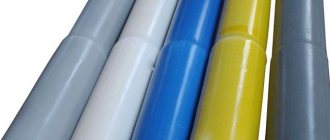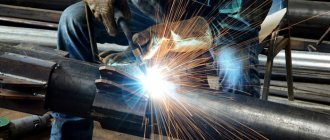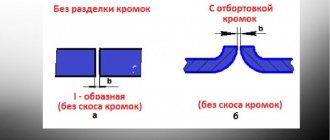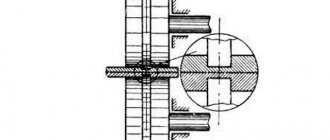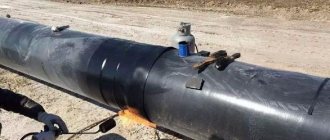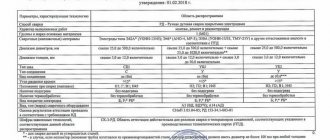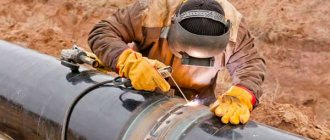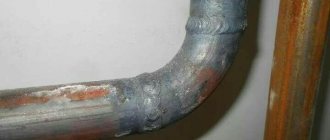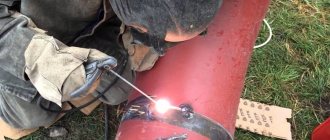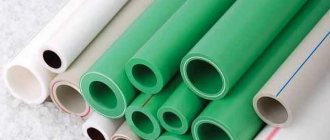11/19/2020 Author: VT-METALL
Issues discussed in the material:
- About preparing pipes for rotary welding
- “Operational” seam during rotary welding of pipes
- Requirements for assembly and welding of pipes using the rotary method
When installing a pipeline, rotary welding of pipes is often used. This is due to the fact that with this joining method, a greater number of seams are made in the lower position, and this, in turn, is considered the most optimal, since the pace and quality of assembly increases.
In our article we will talk about how pipe welding is carried out using the rotary method, what needs to be done at the preparation stage, and we will also analyze the basic requirements that are put forward for the assembly and welding of pipelines.
Content
- The first method of welding a rotary joint
- The second method of welding pipes with a rotating joint
- Third way. Welding of large diameter rotary pipes
- Video: welding rotary pipe joints
- Welding of rotary joints with a pipe diameter less than 200 mm
Penetration of the root of the seam is carried out using electrodes with a diameter of 2-4 mm. The height of the first seam is usually 3-4mm. To perform the second and subsequent layers, electrodes with a larger diameter and higher current are selected. The first and second layers of the seam can be performed in several ways, which are discussed below.
Safety regulations
Safety precautions during welding work.
Any types of welding (gas, electricity, etc.) must be carried out at sites equipped with special equipment. This includes special screens and shields to protect against the effects of electric arcs. These protective devices must be located in such a position that workers present in the room but not involved in welding are fully protected.
If welding of pipes of large diameter and weighing more than 20 kg is carried out, lifting and transport mechanisms must be available. The width of the passage to the welding site must be at least one meter. The temperature in the room where welding is performed must not be lower than +16 degrees Celsius. There must be ventilation and adequate lighting of the welding area.
Persons performing welding work must use special clothing. Welding technology requires grounding of the metal parts of the device; the work table and the transformer housing must also be grounded. The insulation on all cables and wires must be intact and protected from mechanical and temperature damage.
All parts of the device must be made of fire-resistant material. In case of problems in the electrical circuit, only a professional electrician can make corrections with the switch turned off.
Now let's give an example of calculating the volume and mass of deposited metal.
If we proceed from the total length of the electrode of 47 cm and the cross-sectional area of the weld of 0.5 cm and take the specific volume of the deposited metal as 7.8 g/cm, then the volume is equal to the product of the length and the cross-section and the specific volume.
If the length is designated as L, the cross-section as S, and the specific volume as Vsp, then the total volume of deposited metal is equal to the product of L, S and Vsp, which is equal to 1880 g.
The mass of the deposited metal is equal to the product of the volume and the coefficient of the deposited metal and is 1.88 kg/m3 if electrodes of the VSP-1 type with a coefficient of 10 are used.
The first method of welding a rotary joint
The pipeline joint is conventionally divided into 4 approximately identical sections. First, sections 1-2 are welded, then the pipe is turned 180° and sections 3 and 4 are welded. The diagram of this welding method is shown in the figure below.
After welding the first layer, the pipe is turned another 90° and sections 5 and 6 are welded. And then, after turning the pipe another 180°, the remaining sections 7 and 8 are welded.
Differences in the use of consumable and non-consumable electrodes
Welding work is carried out using consumable and non-consumable electrodes.
In the first case, the electrode itself and the area of the welded surface melt. When working with a non-consumable electrode, the arc mixes the molten metal of the surfaces being welded. Consumable electrodes:
- steel:
- copper;
- aluminum.
Non-melting:
- tungsten;
- coal;
- graphite.
Both types are used for welding copper pipes. It is a soft metal and difficult to weld.
Non-consumable electrodes are used for welding galvanized pipes.
The complexity of the work lies in the need to melt the zinc coating. To do this, the heating temperature must reach 1200 °C.
The second method of welding pipes with a rotating joint
Also, as in the first method, the joint is conventionally divided into 4 approximately equal sections. First, sections 1 and 2 are welded, then the pipe is turned 90° and sections 3 and 4 are welded. The diagram of this method is shown in the figure below.
After the first layer of the seam is welded, the pipe is turned 90° and sections 5 and 6 are welded, then the pipe is turned 90° again and sections 7 and 8 are welded.
Necessary equipment, materials and protective equipment
Welding work must be carried out in a spacious, well-ventilated room or in the open air, away from flammable substances. The main working tool for connecting pipes will be an AC or DC electric welding machine. Good equipment costs a lot of money, so for one-time welding, if possible, it is better to borrow it. In addition, you will need:
- fixing devices;
- electrodes and electrode holders;
- welding cable;
- hammer and chisel;
- sandpaper and wire brush.
A prerequisite is the availability of personal protective equipment (PPE). Hands should be protected with thick welding gloves; To protect your head and, above all, your eyes, you will need a welding helmet. It is equipped with darkened glass that “cuts off” the infrared and ultraviolet parts of the light spectrum.
You should work in comfortable, closed clothing that does not restrict movement and made of non-flammable materials.
Third way. Welding of large diameter rotary pipes
This welding method is used for welding large diameter pipes, more than 500 mm. With this method, the joint is divided into several sections and welding is performed in a reverse-step manner. The welding diagram is shown below.
The recommended length of each section of the seam is 150-300mm and it depends on the diameter of the pipeline.
The third layer of the weld, regardless of the method of welding the first layers, is performed in one direction with constant rotation of the pipe.
Preparing for work
The technology for preparing to start welding is as follows: before starting work, you need to prepare the metal, that is, mark, cut and assemble pipes. To do this, you need to install the pipe sections in their original position and clean each joint of slag, rust, dirt, old paint and other deposits. After this, markings should be carried out, that is, using a tape measure, square and scriber, transfer the dimensions of the part from the drawing to the metal. You can use a metal template for this purpose. It should be taken into account that pipe sections are somewhat shortened during the welding process. Therefore, you should leave an allowance using the calculation of 1 mm per transverse joint, 0.1–0.2 per 1 mm of longitudinal seam.
Since pipes have a predominantly round cross-section, thermal cutting is most often used when preparing pipe sections.
Stages of welding polypropylene pipe.
About a third of the total labor intensity is the assembly of parts for welding. When assembling, you should take into account the manufacturer, based on the product series, pipe diameter and other factors. For assembly, so-called welding tacks are used. These are short, lightweight seams with a cross-section of up to one third of a full-fledged seam. The length of the tack depends on the thickness and diameter of the pipe. It can be from 20 to 120 mm. Welding tacks are used to prevent displacement of pipe sections, which can lead to cracks during cooling. When welding pipes of large thickness and diameter with gas or electricity, or welding in an awkward position, assembly is performed using mechanical devices.
In order to ignite the arc, the end of the electrode is short-circuited with the pipe and the electrode is separated from the surface of the pipe. The distance should be equal to the diameter of the coated electrode. This is necessary to heat the metal to the desired temperature at the cathode spot. Heating will release primary electrons.
The following methods are used to ignite the arc: end-to-end and sliding.
When igniting back to back, the metal heats up at the short circuit point. And when the arc is ignited by the sliding method, the metal is heated at several points along the welding surface of the pipe.
The second method is used more often. The first one is used when welding narrow pipes of small diameter in an awkward position.
Welding of rotary joints with a pipe diameter less than 200 mm
If the diameter of the pipeline to be connected does not exceed 200 mm, then the joint can not be divided into sections, but welded with one continuous seam, see the figure below:
In this case, the second and third layers are performed similarly to the first, but each time, with the subsequent layer, the welding direction is changed to the opposite. And in all cases it is necessary to overlap each previous layer with the next one by 10-15mm.
Additional
Technology
Electrodes are selected for the root seam 2 - 3 mm, subsequent ones are thicker. If the wall thickness is more than 12 mm, it is possible to use ANO and UONI grade rods with a thickness of 6 mm on the last layer.
Welding is performed using a DC inverter or transformer. To work in the field with large-diameter parts, rectifiers are used.
On direct current they cook with reverse polarity, applying minus to the part. Alternating current is used for aluminum, non-ferrous alloys and high-alloy steels.
The arc must be kept short, it should not touch the parts being welded, just direct the bath to the right place. Care should be taken to ensure that the slag has time to melt and float.
Parts must be cleaned of dirt and oxides. Edge cutting is not done at the enterprise when rolling products or on a machine as an afterthought.
Hedgehog education
A burr, or urchin, is a hollow formation within a seam or under a layer of spatter . The formation of hedgehogs during pipe welding is a welding defect that has a destructive effect. X-ray illumination detects internal defects, a non-destructive testing method. Most often, burr is formed when welding aluminum. It should be cooked with alternating current, in a jerky method, so that there is no overheating.
To avoid the formation of hedgehogs, you should monitor the gases formed in the bathroom; they must have time to escape. If a stop occurs, you should return 20 - 30 mm, clean the surface of slag and continue, starting to walk along the seam.
You can reduce the amount of agrate by thoroughly cleaning the edges, especially on aluminum. Then rust and dirt will not melt in the bath and contaminate the seam.
To remove tarnish colors without removing the layer with an abrasive wheel, you can use a chemical method. Inox Gel or Stain Clean etching paste is applied to the surface of the pipe. The compositions are very poisonous, you should wear a respirator and gloves and apply with a brush.
Horizontal surfacing
Welding of horizontally positioned butt pipes is considered a rather complex technology. Only a professional welder with certain skills and experience can perform such work. The most difficult thing is the constant adjustment of the electrode to change the angle of inclination.
Welding is performed in three consecutive positions:
- Ceiling.
- Vertical.
- Bottom.
Each seam is made with an individual current value. The ceiling position allows welding at a high power level. All stages involve continuous welding; at the beginning it is best to use the “backward angle” method, and complete the work with the “forward angle”.
